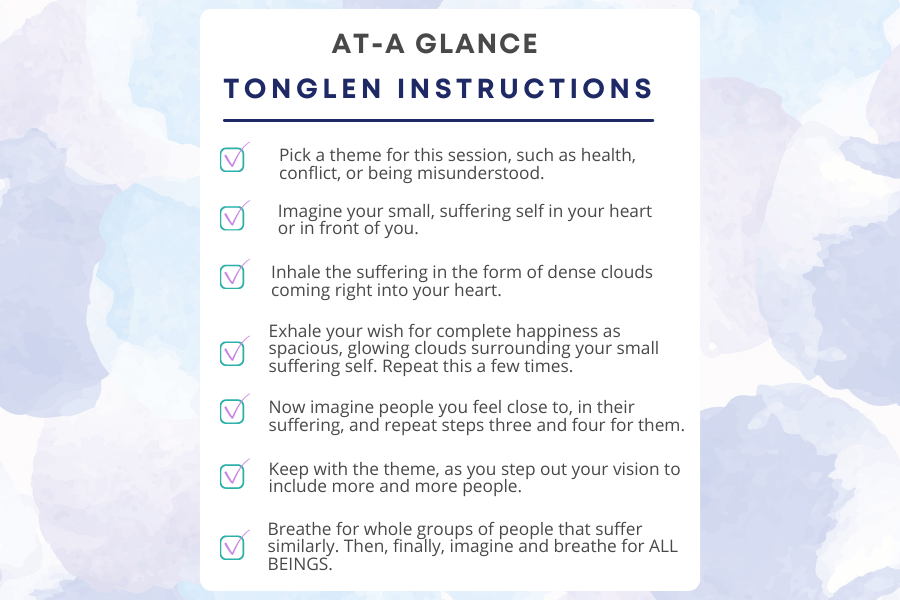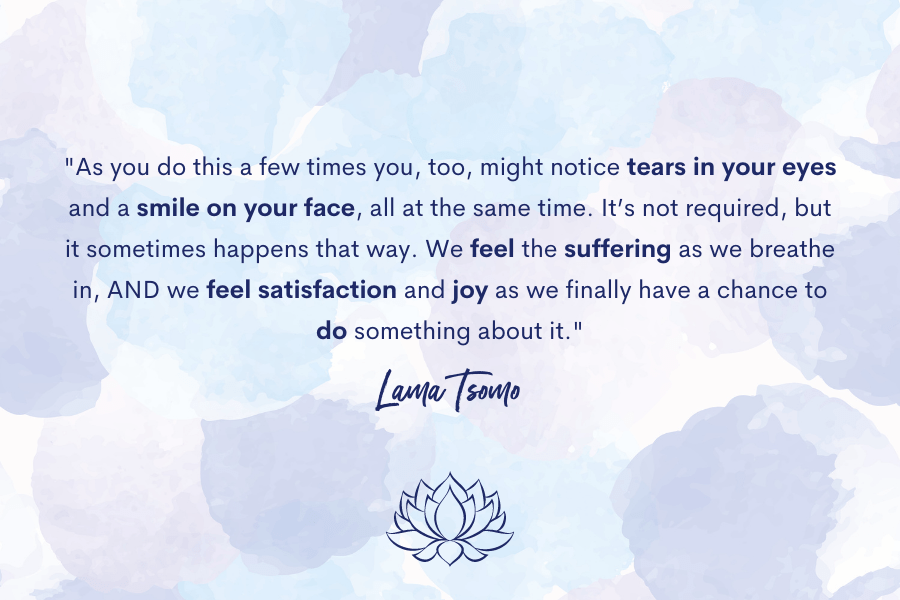In this excerpt from Wisdom & Compassion (Starting with Yourself), Lama Tsomo explains Tonglen or Compassion practice. Through awareness and tapping into the parts of ourselves that are suffering, we’re able to transmute our suffering and the suffering of others. Use this guided Tonglen meditation to send and receive joy, connection, and a sense of relief.
Compassion is also one of the Four Immeasurables or Four Boundless Qualities. Click HERE to read more about those!
What is Tonglen or Compassion Practice?
Tonglen is a Tibetan form of compassion practice that’s used in different forms in all of the lineages of the Dharma. Within Vajrayana (Tibetan Buddhism) there are many sub-branch lineages, all of which practice Tonglen, but as with many of the practices, they vary a bit, from one to another. The word Tonglen means “sending and receiving” in Tibetan. In this practice, we basically imagine breathing in the suffering of others and breathing out our wish for them to be happy.
Preparing for Tonglen or Compassion Practice
Before beginning the practice, I often bring to mind some kind of suffering I’m experiencing in my own life at the moment. Since my life is rarely perfect, I can usually find a juicy subject for my practice. Sometimes I’ve heard of another person who’s suffering terribly, so I naturally focus on that. Then, too, if I hear of a natural disaster or war that destroyed many lives, it’s natural for me to focus on those people and animals. Wherever my passion is, that’s a likely place for me to start the practice of compassion.
For the moment, let’s say you’ve picked your own suffering. Let’s say it’s the feeling that your life is meaningless, and, naturally, you’re upset about that. You’ve got a job that’s meaningless; when you go home, there’s not much meaning going on. You feel powerless to change your life, and you’re coming ever closer to the end of it without hope of doing more meaningful work or having more meaningful relation- ships. I believe this is what Thoreau was referring to when he spoke of most people leading lives of “quiet desperation.” In this situation, you may start with doing Tonglen for yourself, or you may take that strong feeling and begin practicing for someone you care about who is enduring a similar kind of suffering: a dearth of meaning in their life.
If another kind of suffering (yours or someone else’s) is more immediate, though, such as loneliness, grief, guilt, or frustration, then go ahead and pick that. In other words, choose whatever feels most acute and important to you as you prepare to begin.
Tibetans traditionally begin by imagining someone they feel natural sympathy for who has a particular kind of suffering. Many of us in the West have found it really helpful to start with ourselves, an approach which may sound narrowly egotistical, but isn’t necessarily. Since most of us haven’t got enough compassion for ourselves, what basis do we have for expanding that toward others? The Golden Rule, “Do unto others as you would have them do unto you,” doesn’t work if we don’t have compassion for ourselves. It’s the same with “Love thy neighbor as thyself.” Because we Westerners tend to think about painful circumstances (our own, or others’) rather than fully and feelingly experience them, we often do Tonglen more as an intellectual exercise than as a (com)passionate act. This practice is intended to strongly engage our emotion—the positive emotion of compassion.
So the two decisions to make before you start are (1) which “theme” you’re working with and (2) whether you’ll start with yourself or another.
How To Do Tonglen or Compassion Meditation
Sit with your back relatively straight so your yeshe winds are likely to be stronger. The Tibetans say, “When the spine is straight, the channels are straight. When the channels are straight, the winds go straight. When the winds go straight, the mind goes straight.” After having done the Tibetan Nose Blow, you are no doubt coming to understand how this works.
Bring to mind the subject of suffering you’ve chosen. Again, I recommend that you generally start the session by doing Tonglen for yourself.

You then go the next rung out: sending and receiving for someone else—someone you easily feel strong compassion for—who is experiencing the same kind of suffering you have in your life right now. For example, if I’m suffering from my own grief, and I bring to mind a Tibetan friend I know whose father and brothers were all suddenly taken away and never heard from again, I can REALLY feel for her.
The Core of Tonglen
As you begin this practice, I’m assuming you’ve just finished doing Shamata, but if not, first flash on that ultimate ocean of awareness. It has many qualities—such as vastness, absolute power (to create everything), and absolute compassion. This Absolute, or Ultimate, Bodhicitta comes from the awakened mind of Absolute Truth. So “change channels” and bring your mind to that Absolute Bodhicitta level for just a moment as a starting point for this practice.
Now, clearly imagine someone in front of you, someone you easily feel sympathetic to—as we discussed, it could be yourself. Even if the eventual focus of your practice is someone else, I highly recommend you precede this by imagining yourself, in your own suffering. Place your small, suffering self in your heart, or out in front—experiment with what works best for you. Only then should you proceed to do Tonglen, first for yourself, then for your suffering friend, etc., in ever-widening circles. If you’ve chosen victims of a natural disaster or war or catastrophe, then go ahead and start with them. I’d recommend imagining them as individuals, one by one, to start with, so it’s more immediate and intimate. See each face in pain.
Perhaps you’ve already brought your own loneliness up and are feeling the pain of that. Now you open yourself up to the pain of your friend. Now you’re really feeling compassion! Of course you want to take away their suffering. Now’s your chance!
In this movie you’re doing, you breathe in their suffering in the form of dark clouds, coming from them right into your heart. Yes, you breathe it into your heart, where you feel your compassion for them, the part that passionately doesn’t want them to suffer, the part that wants to take their suffering away. This is compassion at work. At this point, I quite often have tears.
In this next part of your movie (sometimes it’s good to make movies in your mind!), you breathe out your wish for them to be happy. This wish appears as white, sparkling clouds, going from your heart to them. It surrounds and soaks into them.
If they’re suffering from a useless life, now you imagine them doing what they’d REALLY love to do, something that fills their hearts with satisfaction. They’re smiling.
If the suffering is loneliness, we imagine them basking in love. Their face is transformed into a huge smile. They’re glowing. We find ourselves smiling too. We want them to be completely free from suffering and happy always.
Let yourself really feel all this. By now, I often find that my eyes still have tears and my mouth now has a smile.
Breathe in the suffering again. You probably didn’t take it all away in the first breath, and you don’t want to leave any suffering, or skimp on giving them joy. You want them 100 percent, permanently happy! Why not eternal bliss?! Send out the joy to them again, on the sparkling clouds of your breath, imagining that now they’re completely enlightened and will remain eternally joyful.
But let’s not stop there. That’s only one person. Now do the same operation for someone else whom you can easily feel compassion for, who has (or has had) a similar kind of suffering. Do a few breaths for them. Now another, then another. People—maybe animals too—are starting to pop up all around you.

Now you’re ready to move to the next rung out. In this rung of concentric circles, you imagine people (or creatures) you don’t have such strong affinity for, perhaps distant acquaintances or people you’ve heard about in passing. Maybe they have a similar kind of suffering. Now that we’ve gotten a tide of compassion going in ourselves, we can feel just about as passionate about also ridding them of suffering. Now that we think of it, we want them to be happy too. Ultimate, everlasting joy—sure! So we breathe for them.
For the next rung out, imagine whole classes of creatures: waifs on the streets of Mexico City, slaves, drug addicts, bullied kids, people dying of cancer, whatever goes with your theme. Riding on the strong waves of passionate compassion, we strongly want to take away their misery too, and make them happy. We breathe for them.
After you’ve done this practice for a few weeks, you may want to really stretch your compassion muscles and do Tonglen for somebody you don’t like, someone who’s caused you trouble. They might even be a troublemaker or enemy. At this point in the practice, you might be able to see them simply as a misguided sentient being, trying to pursue happiness and ending up with suffering. (Sound like anybody you know? Everybody? Yourself, even?) Breathe for them.
At some time or another, EVERY being in Samsara, both seen and unseen, has certainly suffered similarly. They will in the future, too. Since linear time is another illusory appearance, we can breathe for ALL of them. That means absolutely everybody. Who would we want to leave out? So, last, breathe for them all.
Now rest for a bit. This is often a good time to do Shamata again.
Excerpt, pages 66-70, from Ancient Wisdom for Our Times. Tibetan Buddhist Practice: Wisdom & Compassion (Starting with Yourself) (c)2021 Lama Tsomo LLC. Published by Namchak Publishing Company LLC, USA.
